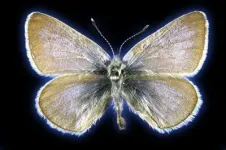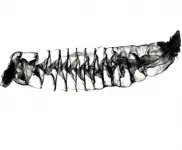(Press-News.org) The Xerces blue butterfly was last seen flapping its iridescent periwinkle wings in San Francisco in the early 1940s. It's generally accepted to be extinct, the first American insect species destroyed by urban development, but there are lingering questions about whether it was really a species to begin with, or just a sub-population of another common butterfly. In a new study in Biology Letters, researchers analyzed the DNA of a 93-year-old Xerces blue specimen in museum collections, and they found that its DNA is unique enough to merit being considered a species. The study confirms that yes, the Xerces blue really did go extinct, and that insect conservation is something we have to take seriously.
"It's interesting to reaffirm that what people have been thinking for nearly 100 years is true, that this was a species driven to extinction by human activities," says Felix Grewe, co-director of the Field's Grainger Bioinformatics Center and the lead author of the Biology Letters paper on the project.
"There was a long standing question as to whether the Xerces blue butterfly was truly a distinct species or just a population of a very widespread species called the silvery blue that's found across the entire west coast of North America," says Corrie Moreau, director of the Cornell University Insect Collections, who began work on the study as a researcher at Chicago's Field Museum. "The widespread silvery blue species has a lot of the same traits. But we have multiple specimens in the Field Museum's collections, and we have the Pritzker DNA lab and the Grainger Bioinformatics Center that has the capacity to sequence and analyze lots of DNA, so we decided to see if we could finally solve this question."
To see if the Xerces blue really was its own separate species, Moreau and her colleagues turned to pinned butterfly specimens stored in drawers in the Field's insect collections. Using forceps, she pinched off a tiny piece of the abdomen of a butterfly collected in 1928. "It was nerve-wracking, because you want to protect as much of it as you can," she recalls. "Taking the first steps and pulling off part of the abdomen was very stressful, but it was also kind of exhilarating to know that we might be able to address a question that has been unanswered for almost 100 years that can't be answered any other way."
Once the piece of the butterfly's body had been retrieved, the sample went to the Field Museum's Pritzker DNA Laboratory, where the tissues were treated with chemicals to isolate the remaining DNA. "DNA is a very stable molecule, it can last a long time after the cells it's stored in have died," says Grewe.
Even though DNA is a stable molecule, it still degrades over time. However, there's DNA in every cell, and by comparing multiple threads of DNA code, scientists can piece together what the original version looked like. "It's like if you made a bunch of identical structures out of Legos, and then dropped them. The individual structures would be broken, but if you looked at all of them together, you could figure out the shape of the original structure," says Moreau.
Grewe, Moreau, and their colleagues compared the genetic sequence of the Xerces blue butterfly with the DNA of the more widespread silvery blue butterfly, and they found that the Xerces blue's DNA was different, meaning it was a separate species.
The study's findings have broad-reaching implications. "The Xerces blue butterfly is the most iconic insect for conservation because it's the first insect in North America we know of that humans drove to extinction. There's an insect conservation society named after it," says Moreau. "It's really terrible that we drove something to extinction, but at the same time what we're saying is, okay, everything we thought does in fact align with the DNA evidence. If we'd found that the Xerces blue wasn't really an extinct species, it could potentially undermine conservation efforts."
DNA analysis of extinct species sometimes invites questions of bringing the species back, à la Jurassic Park, but Grewe and Moreau note in their paper that those efforts could be better spent protecting species that still exist. "Before we start putting a lot of effort into resurrection, let's put that effort into protecting what's there and learn from our past mistakes," says Grewe.
Moreau agrees, noting the urgent need to protect insects. "We're in the middle of what's being called the insect apocalypse-- massive insect declines are being detected all over the world," says Moreau. "And while not all insects are as charismatic as the Xerces blue butterfly, they have huge implications for how ecosystems function. Many insects are really at the base of what keeps many of these ecosystems healthy. They aerate the soil, which allows the plants to grow, and which then feeds the herbivores, which then feed the carnivores. Every loss of an insect has a massive ripple effect across ecosystems."
In addition to the study's implications for conservation, Grewe says that the project showcases the importance of museum collections. "When this butterfly was collected 93 years ago, nobody was thinking about sequencing its DNA. That's why we have to keep collecting, for researchers 100 years in the future."
INFORMATION:
Sophia Antipolis, 21 July 2021: A study of more than 18 million pregnancies has shown a strong and graded relationship between women's heart health and pregnancy outcomes. The research is published today in the European Journal of Preventive Cardiology, a journal of the European Society of Cardiology (ESC).1
The researchers examined the presence of four risk factors for cardiovascular disease in women prior to pregnancy: unhealthy body weight, smoking, hypertension and diabetes. The likelihood of key pregnancy complications - maternal intensive care unit (ICU) admission, preterm birth, low birthweight and foetal death - rose incrementally with the number of pre-pregnancy cardiovascular risk factors.
"Individual cardiovascular risk factors, such as obesity and hypertension, present ...
Any life identified on planets orbiting white dwarf stars almost certainly evolved after the star's death, says a new study led by the University of Warwick that reveals the consequences of the intense and furious stellar winds that will batter a planet as its star is dying. The research is published in Monthly Notices of the Royal Astronomical Society, and lead author Dr Dimitri Veras will present it today (21 July) at the online National Astronomy Meeting (NAM 2021).
The research provides new insight for astronomers searching for signs of life around these dead stars by examining the impact that their ...
Durham, Toronto and Princeton Universities have teamed up with NASA and the Canadian Space Agency to build a new kind of astronomical telescope. SuperBIT flies above 99.5% of the Earth's atmosphere, carried by a helium balloon the size of a football stadium. The telescope will make its operational debut next April and when deployed should obtain high-resolution images rivalling those of the Hubble Space Telescope. Mohamed Shaaban, a PhD student at the University of Toronto, will describe SuperBIT in his talk today (Wednesday 21 July) at the online RAS National Astronomy Meeting (NAM 2021).
Light from a distant galaxy can travel for billions of years to reach our telescopes. In the final ...
CHICAGO --- A woman's heart health before she becomes pregnant is strongly related to her likelihood of experiencing a complication during her pregnancy or labor, reports a new Northwestern Medicine study.
The study examined the presence of four cardiovascular risk factors in women before they became pregnant: smoking, unhealthy body weight, hypertension and diabetes. With the presence of each additional risk factor, the likelihood that the woman would experience an adverse pregnancy outcome got increasingly higher. Those adverse outcomes include maternal intensive care unit (ICU) admission, preterm birth, low birthweight and fetal ...
Contrary to what popular media portrays, we actually don't know much about what sharks eat. Even less is known about how they digest their food, and the role they play in the larger ocean ecosystem.
For more than a century, researchers have relied on flat sketches of sharks' digestive systems to discern how they function -- and how what they eat and excrete impacts other species in the ocean. Now, researchers have produced a series of high-resolution, 3D scans of intestines from nearly three dozen shark species that will advance the understanding of how sharks eat and digest their food.
"It's high time ...
Being more physically active and spending fewer hours per day sitting watching TV is linked to a substantially lower risk of developing obstructive sleep apnoea (OSA), according to new research published in the European Respiratory Journal [1]. It is the first study to simultaneously evaluate physical activity and sedentary behaviour in relation to OSA risk.
OSA is a condition where breathing stops and starts many times during sleep. It reduces oxygen levels in the blood and common symptoms include snoring, disrupted sleep and feeling excessively tired. ...
Study offers first global estimates of the number of children who experienced the death of a parent, grandparent, or primary caregiver from COVID-19.
Researchers estimated figures based on COVID-19 mortality data from March 2020 through April 2021, and national fertility statistics for 21 countries, and extrapolated findings to produce global estimates.
Findings suggest 1 million children have lost a parent, 1.1 million have lost a parent or custodial grandparent, and more than 1.5 million have lost a parent, custodial grandparent, or other secondary familial caregiver from COVID-19.
Authors call for urgent investments in services to support children who have lost their parents and caregivers.
An estimated ...
New research published in Anaesthesia (a journal of the Association of Anaesthetists) by researchers from the University of Bristol can help to improve the efficiency of surgery and help tackle the growing backlog of surgery caused by the COVID-19 pandemic. During the pandemic, the number of patients waiting for routine surgery in the UK has almost doubled with more than 5.3 million people awaiting surgery including more than 300,000 waiting more than a year.
A contributory factor is that COVID-19 precautions have led to many operating theatres working at 75-50% of normal working efficiency. Staff working in operating theatres have been required to take special precautions at the start and end of operations to allow viral particles ...
More than 1.5 million children around the world are estimated to have lost at least one parent, custodial grandparent, or grandparent who lived with them due to death related to COVID-19 during the first 14 months of the pandemic, according to a study published today in The Lancet. The study highlights orphanhood as an urgent and overlooked consequence of the pandemic and emphasizes that providing evidence-based psychosocial and economic support to children who have lost a caregiver must be a key part of responding to the pandemic.
The analysis used mortality and fertility data to model rates of COVID-19-associated orphanhood (death of one or both parents) and deaths of custodial and co-residing grandparents (ages 60-84) from March 1, 2020 to April 30, 2021, across 21 countries. This study ...
Metabolic bone diseases, including osteoporosis, when bones lose their mass and become so fragile that they could be damaged while sneezing or under little stress, are called the silent epidemic of the 21st century. A person does not even know about his illness before the first symptom - it can be a fracture of the spine or the neck of the hip. According to statistics, every third woman and every fifth man after 50 have osteoporosis. Thus, it is promising to search for and obtain substances and materials for implants that have osteoinductive properties and are capable of initiating the processes of transformation of stem cells into bone.
Certain trace elements, such as calcium and magnesium, influence the processes of bone regeneration ...



